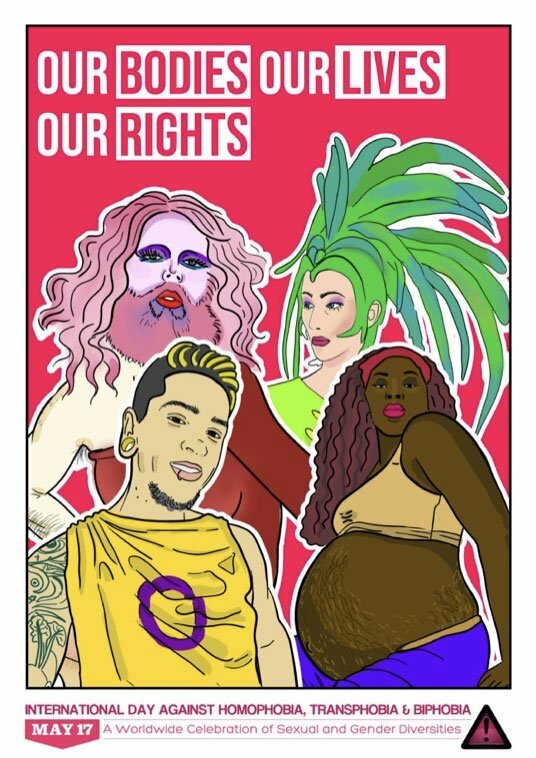Many people are familiar with “PRIDE” – shorthand for “Gay pride” or “LGBT pride” – the annual event that encourages the celebration of lesbian, gay bisexual, transgender, and intersex identities. A lesser known date in the LGBTI+ calendar is May 17th, which is celebrated as the International Day Against Homophobia, Transphobia and Biphobia (IDAHOTB or IDAHOT or IDAHOBIT). It was created in 2004 to draw the attention of policymakers, opinion leaders, social movements, the public, and the media to the ongoing discrimination, violence, and stigma experienced by lesbian, gay, bisexual, transgender, intersex (LGBTI+) people, and all other people with diverse sexual orientations, gender identities, expressions, and sex characteristics.

Many people are familiar with “PRIDE” – shorthand for “Gay pride” or “LGBT pride” – the annual event that encourages the celebration of lesbian, gay bisexual, transgender, and intersex identities. A lesser known date in the LGBTI+ calendar is May 17th, which is celebrated as the International Day Against Homophobia, Transphobia and Biphobia (IDAHOTB or IDAHOT or IDAHOBIT). It was created in 2004 to draw the attention of policymakers, opinion leaders, social movements, the public, and the media to the ongoing discrimination, violence, and stigma experienced by lesbian, gay, bisexual, transgender, intersex (LGBTI+) people, and all other people with diverse sexual orientations, gender identities, expressions, and sex characteristics.
The date of May 17th was chosen to commemorate the World Health Organisation’s landmark decision in 1990 to declassify homosexuality as a mental disorder. Every year, a theme is chosen under which social movements can unite and take action. This year’s theme is “Our Bodies, Our Lives, Our Rights”: a reminder that everyone has the right to decide how they think about their bodies, and how they would like to present themselves to the world.
Although it is becoming increasingly socially acceptable to be “out and proud” and identify as LGBTI+, the situation faced by LGBTI+ people around the world today is still alarming. Misunderstanding, discrimination and fear abound in many parts of the world towards members of the LGBTI community.
As of 2020, only 11 countries in the world have constitutional protection against discrimination based on sexual orientation. 71 countries worldwide still have laws explicitly criminalizing homosexuality as of 2021. A 2020 US study found that LGBTI+ people are nearly 4 times more likely than non-LGBTI+ people to experience violent victimization.
Humanizing LGBTI+ people starts with understanding. Here are a few common myths about LGBTI+ people:
Myth #1: LGBTI+ people can be easily identified by certain mannerisms or physical characteristics
Reality: LGBTI+people come in as many different shapes, sizes and colours as heterosexuals. Some can be identified by stereotypical mannerisms and characteristics. However, many heterosexuals also display these same mannerisms and characteristics, like in the example of “tomboys” or more “effeminate” males. Today, fewer LGBTI+ people feel they need to dress to pass in the mainstream community and some LGBTI+ people choose to make a political statement through their appearance.
Some members of different gay and lesbian subcultures or peer groups may mimic and exaggerate specific behaviours. Because of the lack of open LGBTI+ role models, queer youth sometimes do not know how to “fit in” to the gay community and therefore adopt stereotypical mannerisms thinking that this is the only way to express themselves. Without a wide general knowledge, queer youth can be powerfully influenced by negative stereotypes.
Myth #2: We know what causes homosexuality and bisexuality.
Reality: It is not known what causes either heterosexuality or homosexuality. Many LGBTI+ people know that they are attracted to members of the same sex at an early age, sometimes as young as 6 or 7 years old. Others learn much later in life, in their 30s, 40s, or 50s. Some believe sexual orientation is predetermined genetically and research seems to indicate that sexual orientation is determined either before birth or very early in life. Others maintain that all humans are predisposed to all variations of sexual and affectional behaviours and that they learn a preference or orientation. No one is sure what causes particular orientations.
LGBTI+ people are found in practically every culture throughout the world and have been a constant part of society throughout history. Anthropologists C.S. Ford and F.A. Beach studied 76 contemporary societies and showed that 64% of their sample societies considered homosexuality normal and socially acceptable in their culture. In a majority of cultures, heterosexuality and homosexuality coexist. Same-sex relations were, in fact, accepted and considered natural in many European societies until the 13th century, after which same-sex relations were increasingly prohibited by church and state.
It is not the cause that is important, but that people are treated with dignity and respect regardless of their sexual orientation.
Myth #3: In a Same-Sex Relationship, One Partner Usually Plays the Masculine Role & the Other One Plays the Feminine Role
Reality: Within the heterosexual community, there are all types of relationships and this is true in same-sex relationships. Most same-sex couples work to develop relationships based on the principles of equality and mutuality, where they are loved and appreciated for “who they are”. Roles are usually based on who likes to do a certain thing and/or who has a talent for doing certain things. It is important that each person’s skills are valued. If there is a power imbalance, based on economics, social status, or education, roles may become entrenched.
Myth #4: As opposed to other letters in the community, bisexuality is generally a short-term phase. Bisexual people are also more promiscuous than straight people.
Reality: Some homosexual people who identify as bisexual may come out later in life as gay or lesbian. However, typically, bisexual people have a lifelong attraction to people of more than one gender. Bisexuality is not a phase. Bisexuality as an orientation persists regardless of whether the individual is single or in a relationship with an individual of one gender. Thus, a bisexual partnered with a same-gender person does not “become gay” and a bisexual partnered with a person of another gender does not “become straight.”
Myth #5: A person whose biological sex is a male but feels like a woman inside is still a male.
Reality: Whatever way someone experiences their gender identity should be accepted and respected without judgment or stereotypes of what the gender should be. This should be regardless of the sex they were assigned at birth or how they express themselves currently. In this case, the person is a transwoman as they identify as a woman and should be treated as a woman.
Raising awareness is the first step to change. Here are some Hong Kong organizations we’d like to recognize for their efforts in this regard:
Pink Alliance: Their mission is to advance dignity, acceptance and equal rights for people of different sexual orientations and gender identities in Hong Kong. Check out their calendar of 2022 LGBT events here.
2022 Community Business Awards: Since 2015, Community Business has dedicated 4 awards to recognize company’s efforts in LGBTI+ inclusion. This year’s ceremony will take place on May 26th 2022
If you’d like to participate and mark IDAHOTB 2022, you can share a post on social media about #IDAHOT, learn about LGBTI+ culture, and support LGBTI+ artists and initiatives.
If you are interested in scheduling a session with Bhavna Bharvani or have further queries, please contact us today.
References
https://pinkalliance.hk/pink-blog/lifestyle/lgbt-events-in-hong-kong-2022/
https://www.communitybusiness.org/programmes-campaigns/2020-hong-kong-lgbt-inclusion-awards
https://case.edu/lgbt/safe-zone/sexual-orientation-myths-facts
https://www.acesdv.org/wp-content/uploads/2014/06/WS-Myths-and-Facts-about-the-LGBT-Communities.pdf
https://adm.viu.ca/positive-space/lgtb-myths-facts#
https://www.thoughtworks.com/insights/blog/10-myths-about-lgbtq-community-debunked

